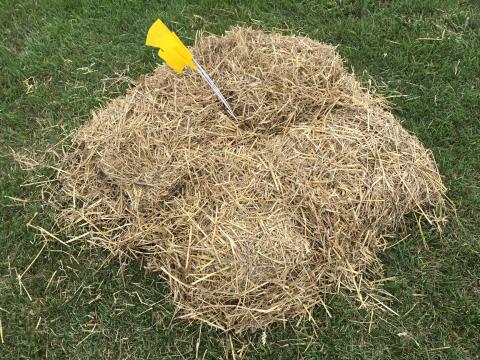
Photo credit Richard Hentschel. Straw mulch preventing soil from freezing.
URBANA, Ill. – Those thinking green this holiday season may want to skip the tree lot and consider buying a living evergreen to plant outside after Christmas.
“The easy part is buying the tree,†says Richard Hentschel, University of Illinois Extension horticulture educator. “Caring for it after when it’s inside and during planting will ensure the tree lasts for years to come.â€
Live evergreen trees can be purchased from nurseries either with the roots and soil balled and burlapped, also known as B&B, or in a container. B&B trees will be heavier and a little more awkward to handle than a container grown tree which uses a light soil mix.
Unlike cut trees, living trees should remain outside until just before Christmas to keep it dormant. Find a shady location or store it on the north side of a building away from direct sunlight.
This is also a good time to pick a roomy spot for the tree’s permanent home. Evergreen branches will be at least 12 to 15 feet wide at the base and unless it’s smaller stature variety, trees can easily be at least 35 feet tall. Layer one or two bales of straw 6 to 8 inches deep over the site to keep the soil from freezing deeply.
Timing for moving the tree indoors and then planting it outdoors is critical.
“Trees should only be inside for four to five days total,†Hentschel says. “Otherwise they may begin to break their winter dormancy and actually start to grow indoors.â€
Keeping the tree’s root ball or container moist before it is planted is important.
Container-grown trees have very efficient drainage and should be checked daily to make sure that the soil is moist. Place a large saucer underneath the container and water the tree evenly and just enough so a little water collects in the saucer.
B&B plants have heavier soil, which holds more moisture but needs more preparation. Use a large watertight container, such as a reusable plastic tub or large pot, filled with moist potting soil or shredded peat moss to support and insulate the root ball.
Once inside where the air is drier, check moisture levels daily.
“If the living tree is shorter than a typical cut tree, consider elevating it on a stable structure, such as cement blocks,†Hentschel says. “The tree is out of reach of pets and there is more room underneath for presents.â€
When the tree is ready to be planted, move the straw and dig a shallow hole that is at least 12 inches wider than the ball or container to give the roots room. Remove the burlap or container and any rope or twine. The root flare, where the base of the trunk starts to flare out, should be at ground level or slightly higher.
Water the newly planted tree well and use the straw to mulch it, which will slow the ground from freezing and allow the roots to acclimate.
“The first year after a tree is planted is important to its long-term success,†Hentschel says. “When spring comes, plan on watering it regularly to supplement the rain as needed.â€
SOURCE:Â Richard Hentschel, Horticulture Educator, Illinois Extension
ABOUT EXTENSION:Â Illinois Extension leads public outreach for the University of Illinois by translating research into action plans that allow Illinois families, businesses, and communities to solve problems, make informed decisions, and adapt to changes and opportunities.

Recent Comments